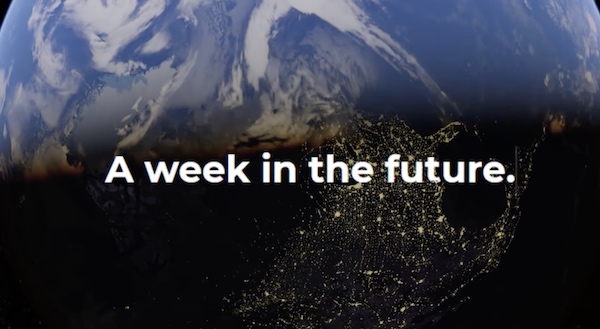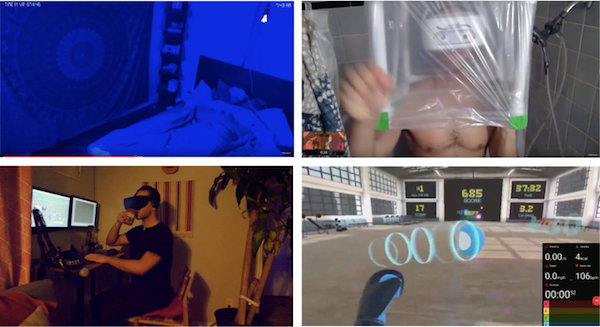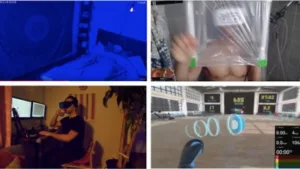Virtual Reality has often been described as an up and coming technology, with very large companies investing significant amounts in this new technology. While the expected consumer adoption is falling far behind initial expectations, the technology is out there and in the hands of enthusiasts spearheading the way for a wider adoption.

While VR and AR seem to be addressing different markets, the technology possibilities are pretty varied. Some VR headsets allow for viewing the real world via camera, creating a virtual reality that contains the real world as one of many realities available via the menu.
Going back many years, we can find some issues with VR headset usage. After the last ‘uprising’ of VR in 1995, studies were conducted to improve the understanding of the effect VR has on people under long time usage. We have to understand that VR back then was more like stereoscopic displays with no head or eye tracking and the limitations of the display technology existing back then. Among others, a scientific summary ‘ Human Factors Issues in Virtual Environments’ by Stanney, Mourant and Kennedy was published in 1999.
In the last few years many publications have brought attention again to the long term effects of VR exposure to the body. Beside many other articles, BBC Science Focus Magazine published the article ‘Virtual Reality: Recognising the Risk’. Interestingly this article looks at VR as a trip into the unknown. While they look at the issue of VR exposure more from an anecdotal view they do not refer to earlier scientific research to this topic. It is very well possible that they do not believe that VR in 1995 is the same as in 2017.
 VR The Future? credit Jak Wilmot video
VR The Future? credit Jak Wilmot video
Besides the more cautious approach of some scientists, today’s YouTube researchers have a complete different approach.
In April 2017, Jack McNee breaks the world’s record for the longest VR marathon. The video shows him playing with a design program for 36 hours while being fed by supporters in the studio. In a certain way he was not really independent in VR as he had a support staff making it happen.
As we all know a world record means someone will be trying to break it. This has just happened when Jak Wilmot from Atlanta, GA spent 1 week (168h) by himself wearing a VR headset. This includes working, sleeping, exercising and even showering with a VR headset on him. A pretty detailed explanation can be found in his 17 min long video.
In contrast to the 36h spent in VR by McNee, he was all by himself when he was doing this. He had a headset with a passthrough function, meaning that he was able to see his environment. He describes the passthrough function of the VR headset as a low resolution image of his room. He also blocked out all the windows so that he was unaware of the day and night changes occurring outside. After a few days, the concept of time became an abstract issue driven by numbers rather than the typical cycles driven by daylight and night.
 Life in VR, credit Jak Wilmot video
Life in VR, credit Jak Wilmot video
He also felt that even simple tasks are more difficult to perform, however he was able to prepare food for himself, even though he did drop a cup of coffee.
Even with a 24h live stream documenting his experiment, he found solitude in some VR environments that took him to other places.
He did experiment with ‘social’ interactions via VR Altspace, where he conferenced with other people around the clock.
In total, he used four different headsets the HTC Vive Focus, Oculus Rift, HTC Vive, and the Oculus Go depending on the tasks at hand. He switched from one headset to another within 5 seconds.
He did report some issues he encountered while doing this experiment. There was mild claustrophobia, burning eyes, frequent déjà vu and a longing for nature. None of these issues caused him to stop the experiment and they all subsided somewhat over time.
Getting used to real life after the experiment caused slight dizziness, disorientation, and the experience of real surroundings not limited by the frame rate of a headset.
Overall he believes:
- VR is connection
- VR is a new medium of human experience
- VR is like being there
He summarized his experience as ‘VR is whatever you want it to be’. This is the closest someone may have come to experiencing the Matrix in real live. While he does not comment on the performance and shortcomings of his used hardware, using different types let me assume that there is not the ‘one fits all’ hardware available today. What impressed me the most was the fact that he was able to sleep with a headset on. -NH

